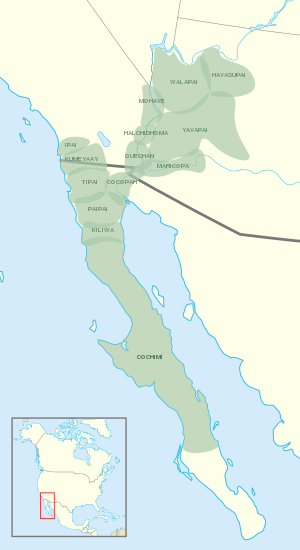| This article includes a list of general references, but it lacks sufficient corresponding inline citations. Please help to improve this article by introducing more precise citations. (December 2019) (Learn how and when to remove this message) |
| Yuman–Cochimí | |
|---|---|
| Yuman | |
| Geographic distribution | Colorado River basin and Baja California |
| Linguistic classification | Hokan ?
|
| Subdivisions | |
| Language codes | |
| Glottolog | coch1271 |
 Pre-contact distribution of Yuman–Cochimí languages Pre-contact distribution of Yuman–Cochimí languages | |
The Yuman–Cochimí languages are a family of languages spoken in Baja California, northern Sonora, southern California, and western Arizona. Cochimí is no longer spoken as of the late 18th century, and most other Yuman languages are threatened.
Classification
There are approximately a dozen Yuman languages. The dormant Cochimí, attested from the 18th century, was identified after the rest of the family had been established, and was found to be more divergent. The resulting family was therefore called Yuman–Cochimí, with Yuman being the extra-Cochimí languages.
- Yuman
- Cochimí † (Northern Cochimí and Southern Cochimí may have been distinct languages)
- Kiliwa
- Core Yuman
- Delta–California Yuman
- River Yuman
- Pai
- Yavapai
- Havasupai-Hualapai (a.k.a. Northern Yuman)
- Hualapai dialect (a.k.a. Walapai)
- Havasupai dialect
- Paipai (a.k.a. Akwa'ala; possibly distinct from the Upland Yuman language only at the dialect level)
Cochimí is now dormant. Cucapá is the Spanish name for the Cocopa. Diegueño is the Spanish name for Ipai–Kumeyaay–Tipai, now often referred to collectively as Kumeyaay. Upland Yuman consists of several mutually intelligible dialects spoken by the politically distinct Yavapai, Hualapai, and Havasupai.
Proto-language
| Proto-Yuman | |
|---|---|
| Reconstruction of | Yuman languages |
| Lower-order reconstructions |
|
Urheimat
Mauricio Mixco of the University of Utah points to a relative lack of reconstructible Proto-Yuman terms for aquatic phenomena as evidence against a coastal, lacustrine, or riverine Urheimat.
Reconstruction
Proto-Yuman reconstructions by Mixco (1978):
gloss Proto-Yuman be *wi/*yu be located (sg) *wa belly *pxa; *p-xa big *tay bird *č-sa body hair *mi(ʔ) bone *ak breasts *ñ-maːy cat *-mi(ʔ) causative *x- chief man *-pa/*(ma) chief, lord *-pa/*ma cold *x-čur cry *mi(ʔ) dance *-ma(ʔ) daughter *p-čay die *pi die (sg) *pi do *wi/uːy do; make *wi/*uy dog *(č)-xat dove *k-wi(ʔ) drink *(č)-si; *si ? ear *ṣma(k)l ~ *ṣmal(k) earth, place *ʔ-mat eat (hard food) *č-aw eat (soft food) *ma extinguish *spa eye *yu(w) face *yu(w) (p)-xu fall *-nal father *n-ʔay; *-ta; *-ku ? feather *-waR fire *ʔ-ʔa(ː)w give *wi; *ʔi he *ña/*ya- head *ʔi(y) hear *kʷi(ː) heaven, sky *ʔ-ma(ʔ)y horn *kʷa ? hot *paR house *ʔ-wa(ʔ) husband *miːy imperative prefix *k- irrealis *-x(a) kill *pi leaf *ṣmak; *smaR lie (be prone) *yak locative *wa-l locative (illative) *-l locative (thither) *-m man, male *-miː(y); *maː(y) man, person *-pa/*ma mother *-tay; *-siy mountain lion *-miʔ tay mountain sheep *ʔ-mu(w) mouth *(y-)a name *maR navel *-pu neck/nape *iː-(m)puk ? non-present aspect *t nose *(p-)xu object, plural *pa object, unspec. (anim.) *ñ- perceive *kʷi possessive prefix (inal.) *ñ prefixes (trans.) *-, *m, *Ø priest *maː(y) pronominal prefixes (stative) *ñ, *m-, *w- pronominal subject *ʔ-, *m-, *Ø rabbit *pxar reed *xta relative pronoun *ña-/*ya relativizer *kʷ- salt *-ʔiR (< *s-ʔiR) say *ʔi shaman *-maː(y) sit *waː skunk *-xʷiw sleep *ṣma son (w.s.) *s-ʔaːw ? star *xmṣi subject suffix *-č; *-m sun, day *paR that *-ña/*-ya there *ña/*ya thing, something *ʔ-č third person *ña-/*ya this *p-u thorn *ʔ-ta(ː)t three *x-muk to blow *p-č/sul tongue *ʔimpal; *(y)pal; *-paR two *x-wak water *-xa(ʔ); *si we *ña-p wife *ku/*ki wing *waR woman *ki/*ku; *siñʔak word *maR yes *xaː
References
- Laylander, Don (2010). "Linguistic Prehistory and the Archaic-Late Transition in the Colorado Desert". Journal of California and Great Basin Anthropology. 30 (2): 141–155. ISSN 0191-3557. JSTOR 23215446.
- Mixco, Mauricio J. 1978. Cochimí and proto-Yuman: lexical and syntactic evidence for a new language family in Lower California. (Anthropological Papers / University of Utah, 101.) Salt Lake City: University of Utah Press.
Bibliography
- Campbell, Lyle. (1997). American Indian Languages: The Historical Linguistics of Native America. Oxford University Press.
- Goddard, Ives. (1996). "Introduction". In Languages, edited by Ives Goddard, pp. 1–16. Handbook of North American Indians, William C. Sturtevant, general editor, Vol. 17. Smithsonian Institution, Washington, D.C.
- Kendall, Martha B. (1983). "Yuman languages". In Southwest, edited by Alfonso Ortiz, pp. 4–12. Handbook of North American Indians, William C. Sturtevant, general editor, Vol. 10. Smithsonian Institution, Washington, D.C.
- Langdon, Margaret. (1990). "Diegueño: how many languages?" In Proceedings of the 1990 Hokan–Penutian Language Workshop, edited by James E. Redden, pp. 184–190. Occasional Papers in Linguistics No. 15. University of Southern Illinois, Carbondale.
- Mithun, Marianne. (1999). The Languages of Native North America. Cambridge: Cambridge University Press. ISBN 0-521-23228-7 (hbk); ISBN 0-521-29875-X.
- Mixco, Mauricio J. (2006). "The indigenous languages". In The Prehistory of Baja California: Advances in the Archaeology of the Forgotten Peninsula, edited by Don Laylander and Jerry D. Moore, pp. 24–41.
External links
- Comparative Yuman Swadesh vocabulary lists (from Wiktionary's Swadesh-list appendix)
| Hokan languages | |||||||
|---|---|---|---|---|---|---|---|
| Shastan | |||||||
| Palaihnihan | |||||||
| Pomoan | |||||||
| Yuman |
| ||||||
| Pakawan | |||||||
| Tequistlatecan | |||||||
| Other | |||||||
| Italics indicate extinct languages | |||||||
| Indigenous language families and isolates of North America | |||||||||||||||||||||||||||||||||||||
|---|---|---|---|---|---|---|---|---|---|---|---|---|---|---|---|---|---|---|---|---|---|---|---|---|---|---|---|---|---|---|---|---|---|---|---|---|---|
| Language families and isolates |
| ||||||||||||||||||||||||||||||||||||
| Proposed groupings | |||||||||||||||||||||||||||||||||||||
| Lists | |||||||||||||||||||||||||||||||||||||